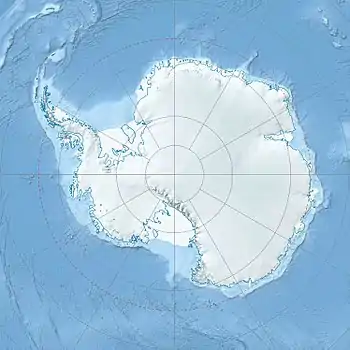| Argo Point | |
|---|---|
 Argo Point | |
| Highest point | |
| Elevation | 360 m (1,180 ft) |
| Coordinates | 66°15′S 60°55′W / 66.25°S 60.92°W[1] |
| Geography | |
| Location | Jason Peninsula, Antarctica |
| Parent range | Seal Nunataks |
| Geology | |
| Mountain type | Volcanic vent |
Argo Point is a scoria cone in Jason Peninsula, Antarctica, at a height of 360 metres (1,180 ft) above sea level.[1] Associated with the Seal Nunataks, the cone has a diameter of 300 metres (980 ft) and its snow-filled crater has a gap on its northern side. The cone is constructed on a formation of lava and scoria over 175 metres (574 ft) thick, which may lie on Jurassic rocks.[2][3]
Potassium-argon dating has indicated ages of 1.4-0.9 mya.[1] The cone is constructed from basalt and hawaiite including lava bombs in its sides.[2] Similar to Seal Nunataks and James Ross Island the rocks of Argo Point are ocean island basalts. This volcanism may be the consequence of back-arc effects of subduction along the South Shetland trench.[4]
See also
References
- 1 2 3 "Argo Point". Global Volcanism Program. Smithsonian Institution.
- 1 2 Smellie, J. L. (1990). "D. Graham Land and South Shetland Islands". Volcanoes of the Antarctic Plate and Southern Oceans. Antarctic Research Series. Vol. 48. p. 352. doi:10.1029/AR048p0302. ISBN 0-87590-172-7.
- ↑ Smellie, J.L. (6 May 2004). "Lithostratigraphy of Miocene–Recent, alkaline volcanic fields in the Antarctic Peninsula and eastern Ellsworth Land". Antarctic Science. 11 (3): 362–378. doi:10.1017/S0954102099000450. S2CID 55742698.
- ↑ Jordan, T.A.; Ferraccioli, F.; Jones, P.C.; Smellie, J.L.; Ghidella, M.; Corr, H. (2007). "High-resolution airborne gravity imaging over James Ross Island (West Antarctica)" (PDF). U.S. Geological Survey and the National Academies. Open-File Report. doi:10.3133/ofr20071047SRP060. Retrieved 28 May 2016.
This article is issued from Wikipedia. The text is licensed under Creative Commons - Attribution - Sharealike. Additional terms may apply for the media files.